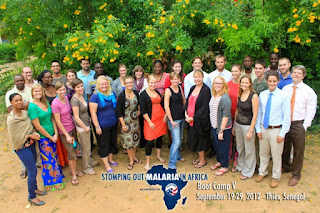In Malinke it is known as “the disease that sits in the birth
place”. In Pulaar, it is described as “the
disease in the stomach of the mother of the baby”. Whatever name you give it, cervical cancer is
the number one cancer killer of women in the developing world. 80% of the estimated 250,000 cervical cancer
deaths occur in developing countries (WHO).
These deaths, which typically happen when a woman is in the prime of her
adult life, were projected to rise by 25% from 2006-2016 in the absence of
urgent action.
Several years ago, an organization called peacecare was
formed with the goal of matching Peace Corps Volunteers to academic
institutions to maximize the strengths of both in taking on global health
issues. My site was chosen as the pilot
site for this innovative partnership and was matched with the University of
Illinois-Chicago. The first peacecare
team came in 2009 in order to do a needs assessment to find the health issue
that would be the focus of this pilot project.
Together with the local health infrastructure, they chose cervical
cancer.
This month, the
fourth peacecare team came to visit, consisting of Dr. Andrew Dykens, a
returned Peace Corps Volunteer who served in Mauritania and the founder of
peacecare, two residents and a medical student from UIC, and a recent MPH grad. It was a whirlwind week, but I left it
feeling extremely enthused about this project.
Our role as Peace Corps Volunteers are to handle on-the-ground logistics,
and facilitate team visits which happen about twice a year. I got to work closely with two fantastic
second year volunteers and learned a lot from them.
In the US, cervical cancer is prevented through regular pap
smears, which is out of the question in a low-resource setting like
Senegal. There are neither the human nor
laboratory resources to even consider this approach. However, a screening methodology known as
Visual Inspection with Acetic Acid (VIA), which is low-tech, simple and
cost-effective is very promising for preventing cervical cancer in this kind of
setting. Through peacecare, midwives and
nurses across the Kedougou region have been trained in this screening
method. Basically, you insert a
speculum, dab a cotton ball with vinegar, touch it to the cervix and wait two
minutes to see if any changes occur with the application of vinegar, indicating
pre-cancer.
It typically takes 10-20 years for an HPV infection to
evolve into invasive cancer (most HPV infections resolve themselves), so there
is a large window for prevention through screening. By January, the peacecare project will have
trained all of the midwives and nurses in the region in the VIA method, and
training on cryotherapy, a treatment method for precancerous lesions that uses
carbon dioxide, will occur in February.
The goal is to eventually move from doing mass screening campaigns to
the incorporation of cervical cancer screening into routine care. With that in mind, the peacecare project has
taken a broader approach to strengthen the local health system, training health
care workers on things like clinical training skills and quality assurance. In order to do this work in a sustainable way
in this region, support will eventually need to come from the Ministry of
Health, and to get them on board, the problem of cervical cancer really needs
to be understood. In January, a
prevalence study will kick off, since we really have no idea how many women are
affected here.
On this trip, a lot of work was done to prepare for the
prevalence study. We did two screening
days in little villages to test out the survey tools. It turned out that they had to be changed
quite a bit—there had been questions designed to measure knowledge about HPV,
which is basically just too difficult to translate into Malinke. The word for germ, virus, and bacteria is all
the same: jangardiŋo, or small disease.
So how do you say Human Papilloma Virus to an illiterate woman who only
speaks Malinke? Another issue was
determining whether a woman fit into the target age range. No one has a clue how old they are, so we had
to try to guess based on how many children someone had. Also, since there are no national guidelines
for screening ages, it has been an interesting exercise to try to come up with
what might eventually become national guidelines based on this study.
The screening days were a great opportunity for me to see
the clinical side of things, which I rarely do.
I sat in the hut or classroom where the screening occurred and wrote
down the woman’s information in the register and timed the process on my watch. Depending on whether the midwife spoke
Malinke, I sometimes helped with translation during the counseling process. It was amazing to see this important health
intervention taking place in the most basic of conditions and exciting to think
that this approach could be scaled up as a national model. This
is the kind of “urgent action” needed to prevent cervical cancer deaths from
drastically increasing like the WHO projects.
 |
| Angel, a fourth year med student and the matron (skilled birth attendant) in Samecouta. Here the screening was conducted in the community health worker's hut. |
 |
| Screening supplies...doing our best to keep things clean on a dirt floor. |
 |
| Agathe, one of the midwives setting up on Day 2 of screening in a classroom. |
The peacecare project actually has its own blog, so check it
out if you’re interested in reading the perspectives of the other team members,
both the volunteers based here and the visitors from Chicago, check it out!
http://www.peacecareworld.blogspot.com





